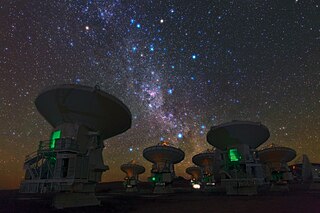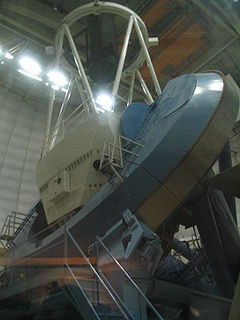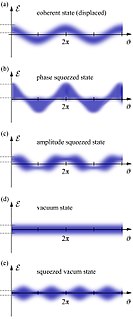Related Research Articles

In physics, interference is a phenomenon in which two waves superpose to form a resultant wave of greater, lower, or the same amplitude. Constructive and destructive interference result from the interaction of waves that are correlated or coherent with each other, either because they come from the same source or because they have the same or nearly the same frequency. Interference effects can be observed with all types of waves, for example, light, radio, acoustic, surface water waves, gravity waves, or matter waves. The resulting images or graphs are called interferograms.

The Very Large Telescope (VLT) is a telescope facility operated by the European Southern Observatory on Cerro Paranal in the Atacama Desert of northern Chile. The VLT consists of four individual telescopes, each with a primary mirror 8.2 m across, which are generally used separately but can be used together to achieve very high angular resolution. The four separate optical telescopes are known as Antu, Kueyen, Melipal, and Yepun, which are all words for astronomical objects in the Mapuche language. The telescopes form an array which is complemented by four movable Auxiliary Telescopes (ATs) of 1.8 m aperture.

Interferometry is a technique in which waves, usually electromagnetic waves, are superimposed, causing the phenomenon of interference, which is used to extract information. Interferometry is an important investigative technique in the fields of astronomy, fiber optics, engineering metrology, optical metrology, oceanography, seismology, spectroscopy, quantum mechanics, nuclear and particle physics, plasma physics, remote sensing, biomolecular interactions, surface profiling, microfluidics, mechanical stress/strain measurement, velocimetry, optometry, and making holograms.

Very-long-baseline interferometry (VLBI) is a type of astronomical interferometry used in radio astronomy. In VLBI a signal from an astronomical radio source, such as a quasar, is collected at multiple radio telescopes on Earth or in space. The distance between the radio telescopes is then calculated using the time difference between the arrivals of the radio signal at different telescopes. This allows observations of an object that are made simultaneously by many radio telescopes to be combined, emulating a telescope with a size equal to the maximum separation between the telescopes.
In physics, two wave sources are perfectly coherent if their frequency and waveform are identical and their phase difference is constant. Coherence is an ideal property of waves that enables stationary interference. It contains several distinct concepts, which are limiting cases that never quite occur in reality but allow an understanding of the physics of waves, and has become a very important concept in quantum physics. More generally, coherence describes all properties of the correlation between physical quantities of a single wave, or between several waves or wave packets.

Absorption spectroscopy refers to spectroscopic techniques that measure the absorption of radiation, as a function of frequency or wavelength, due to its interaction with a sample. The sample absorbs energy, i.e., photons, from the radiating field. The intensity of the absorption varies as a function of frequency, and this variation is the absorption spectrum. Absorption spectroscopy is performed across the electromagnetic spectrum.

Observational astronomy is a division of astronomy that is concerned with recording data about the observable universe, in contrast with theoretical astronomy, which is mainly concerned with calculating the measurable implications of physical models. It is the practice and study of observing celestial objects with the use of telescopes and other astronomical instruments.

In physics, the Mach–Zehnder interferometer is a device used to determine the relative phase shift variations between two collimated beams derived by splitting light from a single source. The interferometer has been used, among other things, to measure phase shifts between the two beams caused by a sample or a change in length of one of the paths. The apparatus is named after the physicists Ludwig Mach and Ludwig Zehnder; Zehnder's proposal in an 1891 article was refined by Mach in an 1892 article. Demonstrations of Mach-Zehnder interferometry with particles other than photons had been demonstrated as well in multiple experiments.

The Michelson interferometer is a common configuration for optical interferometry and was invented by Albert Abraham Michelson. Using a beam splitter, a light source is split into two arms. Each of those light beams is reflected back toward the beamsplitter which then combines their amplitudes using the superposition principle. The resulting interference pattern that is not directed back toward the source is typically directed to some type of photoelectric detector or camera. For different applications of the interferometer, the two light paths can be with different lengths or incorporate optical elements or even materials under test.
Aperture synthesis or synthesis imaging is a type of interferometry that mixes signals from a collection of telescopes to produce images having the same angular resolution as an instrument the size of the entire collection. At each separation and orientation, the lobe-pattern of the interferometer produces an output which is one component of the Fourier transform of the spatial distribution of the brightness of the observed object. The image of the source is produced from these measurements. Astronomical interferometers are commonly used for high-resolution optical, infrared, submillimetre and radio astronomy observations. For example, the Event Horizon Telescope project derived the first image of a black hole using aperture synthesis.
In physics, the Hanbury Brown and Twiss (HBT) effect is any of a variety of correlation and anti-correlation effects in the intensities received by two detectors from a beam of particles. HBT effects can generally be attributed to the wave–particle duality of the beam, and the results of a given experiment depend on whether the beam is composed of fermions or bosons. Devices which use the effect are commonly called intensity interferometers and were originally used in astronomy, although they are also heavily used in the field of quantum optics.

The Narrabri Stellar Intensity Interferometer (NSII) was the first astronomical instrument to measure the diameters of a large number of stars at visible wavelengths. It was designed by Robert Hanbury Brown, who received the Hughes Medal in 1971 for this work. It was built by University of Sydney School of Physics and was located near the town of Narrabri in north-central New South Wales, Australia. Many of the components were constructed in the UK. The design was based on an earlier optical intensity interferometer built by Hanbury Brown and Richard Q. Twiss at Jodrell Bank in the UK. Whilst the original device had a maximum baseline of 10m, the NSII device consisted of a large circular track that allowed the detectors to be separated from 10 to 188m. The NSII operated from 1963 until 1974, and was used to measure the angular diameters of 32 stars.
The interferometric visibility quantifies the contrast of interference in any system which has wave-like properties, such as optics, quantum mechanics, water waves, sound waves, or electrical signals. Generally, two or more waves are combined and as the phase difference between them varies, the power or intensity of the resulting wave oscillates, forming an interference pattern. The pattern may be visible all at once because the phase difference varies as a function of space, as in a 2-slit experiment. Alternately, the phase difference may be manually controlled by the operator, for example by adjusting a vernier knob in an interferometer. The ratio of the size or amplitude of these oscillations to the sum of the powers of the individual waves is defined as the visibility.

An astronomical interferometer is an array of separate telescopes, mirror segments, or radio telescope antennas that work together as a single telescope to provide higher resolution images of astronomical objects such as stars, nebulas and galaxies by means of interferometry. The advantage of this technique is that it can theoretically produce images with the angular resolution of a huge telescope with an aperture equal to the separation between the component telescopes. The main drawback is that it does not collect as much light as the complete instrument's mirror. Thus it is mainly useful for fine resolution of more luminous astronomical objects, such as close binary stars. Another drawback is that the maximum angular size of a detectable emission source is limited by the minimum gap between detectors in the collector array.

The Virgo interferometer is a large interferometer designed to detect gravitational waves predicted by the general theory of relativity. Virgo is a Michelson interferometer that is isolated from external disturbances: its mirrors and instrumentation are suspended and its laser beam operates in a vacuum. The instrument's two arms are three kilometres long and located in Santo Stefano a Macerata, near the city of Pisa, Italy.
Quantum imaging is a new sub-field of quantum optics that exploits quantum correlations such as quantum entanglement of the electromagnetic field in order to image objects with a resolution or other imaging criteria that is beyond what is possible in classical optics. Examples of quantum imaging are quantum ghost imaging, quantum lithography, sub-shot-noise imaging, and quantum sensing. Quantum imaging may someday be useful for storing patterns of data in quantum computers and transmitting large amounts of highly secure encrypted information. Quantum mechanics has shown that light has inherent “uncertainties” in its features, manifested as moment-to-moment fluctuations in its properties. Controlling these fluctuations—which represent a sort of “noise”—can improve detection of faint objects, produce better amplified images, and allow workers to more accurately position laser beams.
In optical astronomy, interferometry is used to combine signals from two or more telescopes to obtain measurements with higher resolution than could be obtained with either telescopes individually. This technique is the basis for astronomical interferometer arrays, which can make measurements of very small astronomical objects if the telescopes are spread out over a wide area. If a large number of telescopes are used a picture can be produced which has resolution similar to a single telescope with the diameter of the combined spread of telescopes. These include radio telescope arrays such as VLA, VLBI, SMA, LOFAR and SKA, and more recently astronomical optical interferometer arrays such as COAST, NPOI and IOTA, resulting in the highest resolution optical images ever achieved in astronomy. The VLT Interferometer is expected to produce its first images using aperture synthesis soon, followed by other interferometers such as the CHARA array and the Magdalena Ridge Observatory Interferometer which may consist of up to 10 optical telescopes. If outrigger telescopes are built at the Keck Interferometer, it will also become capable of interferometric imaging.

A white light scanner (WLS) is a device for performing surface height measurements of an object using coherence scanning interferometry (CSI) with spectrally-broadband, "white light" illumination. Different configurations of scanning interferometer may be used to measure macroscopic objects with surface profiles measuring in the centimeter range, to microscopic objects with surface profiles measuring in the micrometer range. For large-scale non-interferometric measurement systems, see structured-light 3D scanner.
A superluminescent diode is an edge-emitting semiconductor light source based on superluminescence. It combines the high power and brightness of laser diodes with the low coherence of conventional light-emitting diodes. Its emission band is 5–1530 nm wide, Zeiss Plex Elite 9000 boasts an SLD at 750nm, and LD-PD inc boasts SLDs of up to 1480nm and 1530nm.

In quantum physics, light is in a squeezed state if its electric field strength Ԑ for some phases has a quantum uncertainty smaller than that of a coherent state. The term squeezing thus refers to a reduced quantum uncertainty. To obey Heisenberg's uncertainty relation, a squeezed state must also have phases at which the electric field uncertainty is anti-squeezed, i.e. larger than that of a coherent state.
References
- ↑ Fox, Mark (April 28, 2006). Quantum Optics: An Introduction. Oxford University Press. p. 105-108. ISBN 9780191524257.